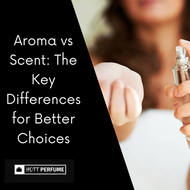Aroma vs Scent: Key Differences for Better Choices
Posted by Tina Wilson on Sep 3rd 2025

The terms aroma, fragrance and scent are often used interchangeably, but they have distinct meanings. Aroma typically refers to a pleasant scent, commonly associated with food, spices, and plants. It conveys a positive connotation and is used to describe enjoyable fragrances. In contrast, scent is a broader term that encompasses any smell—pleasant or unpleasant. It is often used to describe the odors of animals, perfumes, flowers, or even less agreeable smells.
The key difference lies in their connotation and usage: aroma generally implies a pleasant fragrance, while scent can refer to any type of smell regardless of its nature. Understanding this distinction helps people more accurately describe and differentiate smells, whether it’s the inviting fragrance and scent of pine trees or the distinctive scent of coffee, for example .
Additionally, the word fragrance is commonly used in the context of perfumes and refers specifically to a pleasant smell, often created using fragrance oils.
Best Designer Scents at Affordable Prices
Aroma vs Scent: Similarities of pleasant fragrance
While aroma and scent have distinct meanings and connotations, they also share several similarities that often lead to their interchangeable use in everyday language:
-
Both Relate to Smell: At their core, both terms describe the perception of odors detected by the olfactory system. They refer to the presence of airborne molecules that evoke sensory responses.
-
Used to Describe Pleasant Smells: Although scent can refer to any smell, it is frequently used to describe pleasant fragrances, much like aroma. For example, people often talk about the “scent of flowers” or the “aroma of fresh bread” to highlight enjoyable smells.
-
Common in Describing Fragrances: Both words are commonly used in the context of perfumes, candles, and other fragranced products to evoke sensory appeal. They help convey the character and quality of a fragrance.
-
Enhance Sensory Experience: Whether describing food, nature, or products, both aroma and scent enrich the description by appealing to the sense of smell, adding depth and emotion to the experience.
-
Cultural and Contextual Overlap: In many cultures and languages, the distinction between the two terms is subtle or nonexistent, leading to overlapping usage depending on context and personal preference.
Understanding these similarities helps explain why aroma and scent are often used interchangeably, and any mistake in their usage even though they carry different nuances in specific contexts.
Key Differences and Usage
|
Aspect |
Aroma |
Scent |
|---|---|---|
|
Definition |
Refers specifically to pleasant smells, often related to food, spices, and plants. |
A broader term encompassing any smell, pleasant or unpleasant. |
|
Common Usage |
Used to describe enjoyable, distinctive smells like freshly baked bread or herbs. |
Used for a wide range of smells including perfumes, flowers, animals, and even unpleasant odors. |
|
Connotation |
Generally positive, implying a pleasing fragrance. |
Neutral; can refer to both pleasant and unpleasant odors. |
|
Contextual Examples |
The aroma of coffee is rich and distinctive; the aroma of herbs is fresh and inviting. |
The scent of perfume can be floral; the scent of an animal can be musky or strong. |
|
Specificity |
More specific, often linked to food and natural pleasant smells. |
More general, covering all types of smells regardless of quality. |
|
Relation to Fragrance For guidance on selecting the most suitable cologne for outdoor work, see Discover the Best Cologne for Working Outside. |
Closely related to fragrance, which also implies a pleasant smell, often artificially created. |
Scent includes fragrance but also natural and artificial odors, pleasant or not. |
|
Purpose in Language |
Helps convey the pleasant sensory experience of smell, often used in culinary and botanical contexts. |
Used to describe and identify a wide variety of smells in everyday life, including both positive and negative. |
What Are Niche Fragrances? A Guide to Unique Scents
This table highlights the nuanced differences between aroma and scent, clarifying their distinct meanings, typical uses, and connotations to better understand how each term applies to different types of smells.
Conclusion
Knowing the difference between aroma and scent helps us better describe and enjoy different smells. Although these words are often used as if they mean the same thing, they actually have different meanings. Aroma usually refers to pleasant smells, like those from food, spices, or plants, and gives a positive feeling. On the other hand, scent is a more general word that can mean any smell, good or bad, such as perfumes, flowers, or animal odors.
Understanding these differences makes it easier to talk about smells clearly, whether you’re describing the rich aroma of coffee or the floral scent of a perfume. The word fragrance is similar to aroma but is mostly used for nice smells made with special oils, especially in perfumes and cologne.
Even though they differ, aroma and scent share some common ground. Both relate to how we sense odors and are often used to talk about pleasant natural smells. They add meaning and feeling to how we experience food, nature, and products. In many languages and cultures, these words are used in similar ways, which can make the difference less clear. In short, aroma tends to be more specific and characteristic, positive, while scent is broader and neutral. Knowing when to use each word helps us describe smells more accurately and makes our conversations richer.
Overall, understanding these terms can act to improve how we talk about smells and helps us connect more deeply with the world through our sense of smell.


